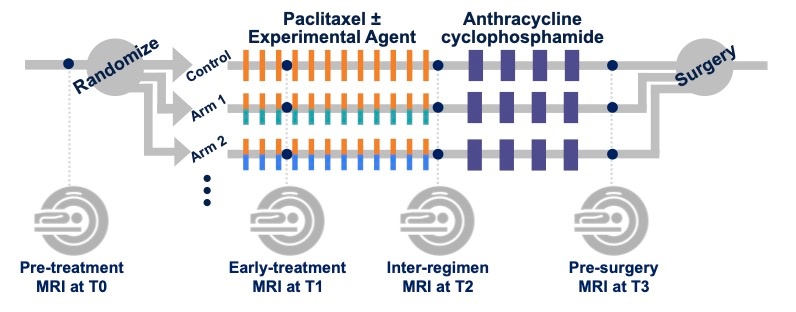Summary
| Redirect | ||||
|---|---|---|---|---|
|
| Excerpt |
|---|
I-SPY 2 (Investigation of Serial studies to Predict Your Therapeutic Response with Imaging And moLecular analysis 2) is an ongoing, multi-center trial (NCT01042379) designed to quickly evaluate the efficacy of new agents for breast cancer in neoadjuvant chemotherapy (NAC) setting. Women aged ≥18 years diagnosed with locally advanced breast cancer (tumor size ≥2.5 cm) without distant metastasis are eligible to enroll in the trial. Patients with breast cancer at high-risk for recurrence are adaptively-randomized to either control arm (standard NAC) or one of several concurrent experimental drug arms. I-SPY 2 utilizes change in tumor volume by DCE-MRI at serial time-points during NAC to adjust the randomization schema as the trial proceeds, preferentially assigning patients to receive agents showing an increasing likelihood of efficacy against their breast cancer subtype. I-SPY 2 opened in Spring 2010 and is ongoing. This collection includes DCE MRI data (original acquired images and derived parametric maps) for I-SPY 2 patients adaptively randomized between 2010 and 2016, along with histopathologic outcome data. Breast MRI data in this collection was acquired prospectively at over 22 clinical centers using a standardized image acquisition protocol. Patients underwent 4 MRI exams before and during NAC and over 95% of the DCE imaging data met acceptance criteria for analysis of functional tumor volume (FTV), a demonstrated quantitative imaging marker of breast cancer response to NAC. This is a comprehensive, highly curated imaging data set with histopathologic outcome that can be used to develop, test and compare imaging metrics and prediction models for breast cancer response to treatment. Original but uncurated T2weighted MRI images are also included for most studies. 719 patients are included in this collection. In combination with 266 patients from the ACRIN-6698/ISPY2 TCIA collection these 985 patients comprise "I-SPY2 Imaging Cohort 1", the 1st subgroup of publicly released imaging data from the I-SPY 2 TRIAL. All subjects in the I-SPY2 Imaging Cohort 1 were enrolled in I-SPY 2 from 2010 to 2016 and randomized to one of nine completed experimental drug arms or control arm. In order to obtain the MRI data for the entire I-SPY2 Imaging Cohort 1 please download using the manifest file provided in the Data Access table below as this will include the patients from both collections. Downloading this collection alone will result in an incomplete cohort of 719 patients and any results from that patient set will not be comparable to published results from the trial. In addition, a retrospective study using a 384 patient subset (median age: 49 y/o) was performed to test if prediction models combining multiple MRI features outperform models with single features. Four features were quantitatively calculated in each MRI exam: functional tumor volume, longest diameter, sphericity, and contralateral background parenchymal enhancement. Logistic regression analysis was used to study the relationship between MRI variables and pathologic complete response (pCR). Predictive performance was estimated using the area under the receiver operating characteristic curve (AUC). The cohort was stratified by hormone receptor (HR) and human epidermal growth factor receptor 2 (HER2) status (positive or negative). Results showed analysis with combined features achieved higher AUCs than analysis with any feature alone. These results are further described in the associated publication and in the multi-feature MRI spreadsheet included with this Collection. |
...
